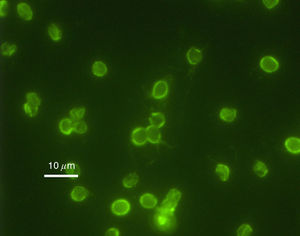Shock chlorination: Difference between revisions
From MicrobeWiki, the student-edited microbiology resource
| Line 11: | Line 11: | ||
===<i>Cryptosporidium</i>=== | ===<i>Cryptosporidium</i>=== | ||
[[Image:Cryptosporidium1.jpeg|thumb|300px|right|Immunofluorescence of <i>Cryptosporidium</i>, the microbe that caused an epidemic in Milwaukee in 1993. Over 104 deaths were credited to the waterborne microbe . Courtesy: [http://www.epa.gov/microbes/cpt_seq1.html H.D.A Lindquist (EPA)]]] | [[Image:Cryptosporidium1.jpeg|thumb|300px|right|Immunofluorescence of <i>Cryptosporidium</i>, the microbe that caused an epidemic in Milwaukee in 1993. Over 104 deaths were credited to the waterborne microbe . Courtesy: [http://www.epa.gov/microbes/cpt_seq1.html H.D.A Lindquist (EPA)]]] | ||
<i>[http://microbewiki.kenyon.edu/index.php/Cryptosporidium Cryptosporidium parvum]</i> | <i>[http://microbewiki.kenyon.edu/index.php/Cryptosporidium Cryptosporidium parvum]</i> is a type of parasite capable of causing gastrointestinal illness. Unlike <i>Helicobacter pylori</i>, however, <i>Cryptosporidium</i> has been proven to be unresponsive to chlorination (citation needed). | ||
<br> | <br> | ||
Revision as of 01:22, 4 November 2013
Introduction
From swimming pools to wells, chlorine is a common chemical used to disinfect water sources.
Microbial agents
Helicobacter pylori

Electron micrograph of Helicobacter pylori, a microbe commonly found in public water sources. Courtesy: Timothy Hoover (Franklin College)
Helicobacter pylori is known to cause gastritis and peptic ulcers.
Cryptosporidium

Immunofluorescence of Cryptosporidium, the microbe that caused an epidemic in Milwaukee in 1993. Over 104 deaths were credited to the waterborne microbe . Courtesy: H.D.A Lindquist (EPA)
Cryptosporidium parvum is a type of parasite capable of causing gastrointestinal illness. Unlike Helicobacter pylori, however, Cryptosporidium has been proven to be unresponsive to chlorination (citation needed).
Methods
Success rates
Alternative methods
References
Edited by Erika Jensen, student of Joan Slonczewski for BIOL 116 Information in Living Systems, 2013, Kenyon College.
